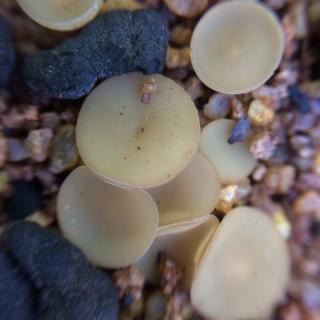GRDC Perth Research Updates 2023 – Pathology and virology
In this Protecting WA Crops issue we cover plant pathology and virology research topics presented and written by Department of Primary Industries and Regional Development (DPIRD) staff for the 2023 Perth GRDC Research Update’s held in February.
To read about the invertebrate research covered by DPIRD staff refer to the previous Protecting WA Crops Issue 28.
How long do Sclerotinia sclerotia survive in WA? Decision support tools to help with on-farm management of blackleg and sclerotinia in canola
At a glance:
- Trials at Northam revealed that Sclerotinia sclerotiorum sclerotia still produce apothecia after six seasons on the soil surface.
- DPIRD and GRDC have developed three tools to support on-farm management decisions for key diseases in canola -BlacklegCM for blackleg stem canker, UCI BlacklegCM for blackleg upper canopy infection (UCI) and SclerotiniaCM for sclerotinia stem rot (SSR) management.
- The UCI BlacklegCM app was released in mid-2022 and has since been updated to take account of blackleg leaf lesions on canola varieties that are rated as resistant.
Sclerotinia stem rot and sclerotia survival
Sclerotinia stem rot (SSR) is a fungal disease of canola, that can cause significant yield losses exceeding 20 per cent under conducive conditions. Sclerotia are structures utilised by a range of fungi to survive adverse environmental conditions. Sclerotinia sclerotiorum, which causes SSR in canola in WA, has been observed to form sclerotia within the stems, on the outside of the stems, in pods, on the crown and on the roots of canola plants. Sclerotia germinate the following season to produce apothecia, which are tiny spore bearing mushrooms.
Previous global research on survival rates of sclerotia indicated that sclerotia could survive three to four years on the soil surface and initiate SSR during that time. Department of Primary Industries and Regional Development (DPIRD) plant pathologist Jean Galloway investigated sclerotia survival in WA environmental conditions in a trial at Northam.
Sclerotia were collected from a 2016 canola crop and placed on the soil surface in a 10 centimetre diameter pvc ring and was monitored weekly from May to October for apothecia production. Ms Galloway found that after six seasons the sclerotia were still producing apothecia, although sclerotia did not germinate every season. This exceeded the former literature for sclerotia survival, indicating the potential for sclerotia to survive in WA farming conditions and potentially cause infection in canola and other broadleaf crops many years later. This trial is ongoing and will continue this season.
Decision support tools
The Grains Research and Development Corporation (GRDC) and DPIRD, in collaboration with canola pathology experts across Australia, have produced a series of decision support tools to assist growers with managing sclerotinia stem rot (SSR) and blackleg.
The SclerotiniaCM app was released in 2019 and provides disease management decision support for SSR in flowering canola crops. Ten on-farm validation trials were conducted in 2019, 2020 and 2022. These trials revealed that SclerotiniaCM was accurate in predicating circumstances in which SSR can develop in canola crops. In 2019, which was a below average rainfall season, this tool proved valuable in helping growers avoid unnecessary fungicide applications.
The BlacklegCM decision support tool was released in 2018 to assist with on-farm disease management decisions for blackleg stem canker at sowing and early crop vegetative stages of canola. This tool is updated twice a year with the latest variety resistance information.
Blackleg upper canopy infection (UCI) occurs more often since growers have shifted to earlier sowing of canola. The UCI BlacklegCM app was released in 2022 to assist with disease management decisions from first flowers through to early flowering (20-30 per cent bloom stage) of canola crops. The tool was tested in trials last season where early sown canola crops were checked for blackleg UCI at more than 20 locations across WA.
Blackleg leaf lesions were found at the time of first flowers in most varieties and most locations, including resistant (R) canola varieties. When the UCI BlacklegCM tool was run for these R varieties it predicted a potential for yield limiting levels of blackleg UCI to develop, with a potential for a positive economic return for fungicide application. Yet current research suggests canola varieties with a higher level of resistance to blackleg stem canker (R varieties) may not develop yield limiting UCI. To account for this, the tool has been updated with an additional function that asks users to enter resistance ratings of the canola variety sown. This new functionality will prevent the UCI BlacklegCM from predicting a positive return for fungicide application on R varieties that have leaf lesions at the time of flowering.
More information on sclerotinia stem rot and the decision support tools can be found in Ms Galloway’s Research Updates paper: How long do Sclerotinia sclerotia survive in WA? Decision support tools to help with on-farm management of blackleg and sclerotinia in canola.
You can also listen to the DPIRD Grains Convo podcast Canola in the high rainfall zone and disease modelling tools.
For more information on blackleg refer to DPIRD’s Managing blackleg in canola webpage.
For more information on Sclerotinia stem rot refer to DPIRD’s Managing sclerotinia stem rot in canola webpage.
To read more about the apps visit the following DPIRD webpages:


